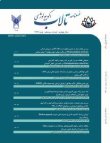Frequency changes of Artemia Urmiana fecal pellets in the bed sediments of the Urmia Lake: implications on the paleoclimate
Urmia Lake is one of the biggest over-saturated salt lakes of the world. It is located at the northwestern part of Iran. The temporal change in the concentration of Artemia fecal pellets can be used as an indicator of lake level changes, paleoclimate and therefore regional hydrological changes. In this study basis on the previous data collection, 28 sedimentary intact cores with a maximum depth of 10 meters and a total of more than 200 meters were sampled from the lake sediments by Gouge Auger coring method. Sedimentary facies were separated based on color, grain size, existence of Artemia fecal pellets, sedimentary fabrics and the type of evaporative minerals. With regard to vertical sedimentary facies (from surface to sub-surface areas) changes and the results of elemental analysis, geography, climatic conditions and lake water level fluctuation were re-constructed. Facies belong to Lake, Lagoon, River and Playa environments. According to the age measurement by isotope carbon-14 method, deposition rate is between 0.7 to 0.8 mm per year, but this rate was varied in different parts of the lake (1.0 to 1 mm per year), this amount was maximum in river delta (mostly west of lake). Artemia fecal pellets constitute about 5-35% in average and 90% in maximum of the deposits. Fecal pellets of Artemia that formed of aragonite prismes were one of the biochemical sediments of the lake that mostly intact pellets or crushed cream color and black pyrite pellets are observed. Finding Artemia fecal pellets as old as early Holocene, showing that this Crustacean lived in the lake since at least the beginning of the Holocene. Sediments study shows that the organic content of fecal pellets gradually diminishes down the cores. Increase in amount of fecal pellets was match with wet interglacial periods in South Asia and Africa (4 to 10 thousand years ago). These periods also shows wet conditions with sediment geochemistry studies. The Urmia lake level fluctuations can be a major factor in controlling the high temporal variations in the abundance of Artemia fecal pellets. However, caution should be taken in the interpretations as other environmental factors, such as temperature changes, water circulation, taphonomic history, etc.
- حق عضویت دریافتی صرف حمایت از نشریات عضو و نگهداری، تکمیل و توسعه مگیران میشود.
- پرداخت حق اشتراک و دانلود مقالات اجازه بازنشر آن در سایر رسانههای چاپی و دیجیتال را به کاربر نمیدهد.


